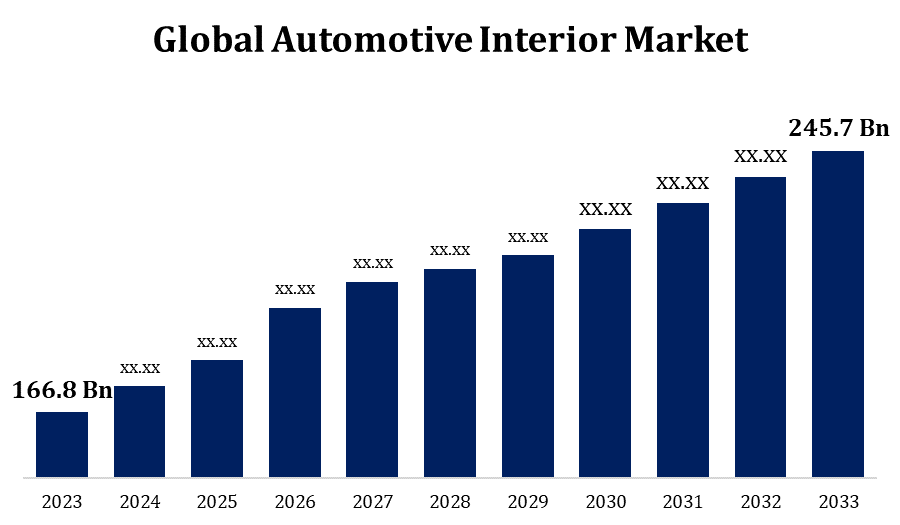Global Automotive Interior Market Size To Worth USD 245.7 Billion By 2033 | CAGR of 3.95%
Category: Automotive & TransportationGlobal Automotive Interior Market Size To Worth USD 245.7 Billion By 2033
According to a research report published by Spherical Insights & Consulting, The Global Automotive Interior Market Size to grow from USD 166.8 Billion in 2023 to USD 245.7 Billion by 2033, at a Compound Annual Growth Rate (CAGR) of 3.95% during the forecast period.

Get more details on this report -
Browse key industry insights spread across 256 pages with 120 Market data tables and figures & charts from the report on the "Global Automotive Interior Market Size, Share, and COVID-19 Impact Analysis, By Component (Center Stack, Head-Up Display, Instrument Cluster, Rear Seat Entertainment, Dome Module, Headliner, Seat, Interior Lighting, Door Panel, Adhesives & Tapes, Others), By Material (Leather, Fabric, Vinyl, Wood, Glass Fiber, Composite, Carbon Fiber Composite, Metal), By The Level of Autonomy (Semi-Autonomous, Autonomous, Non-autonomous), and By Region (North America, Europe, Asia-Pacific, Latin America, Middle East, and Africa), Analysis and Forecast 2023 - 2033." Get Detailed Report Description Here: https://www.sphericalinsights.com/reports/automotive-interior-market
The automotive interior market is a dynamic sector experiencing significant growth due to advancements in technology, shifting consumer preferences, and increased demand for comfort and customization. It includes various components such as seating, dashboards, door trims, center consoles, and flooring. The rise of electric vehicles (EVs) and autonomous driving technologies has spurred demand for high-quality, eco-friendly, and technologically advanced interior materials. Key trends include the integration of advanced infotainment systems, the use of lightweight materials like carbon fiber and composites, and a focus on sustainable solutions such as recycled plastics and natural fibers. Asia-Pacific holds the largest market share, driven by high vehicle production and growing consumer demand. The market is also seeing innovations in design and manufacturing processes aimed at improving safety, aesthetics, and functionality.
Automotive Interior Market Value Chain Analysis
The automotive interior market value chain spans several key stages from raw material procurement to final product delivery. It begins with sourcing materials such as plastics, fabrics, metals, and electronic components. These materials are processed and assembled into various components like seats, dashboards, door panels, and infotainment systems. Suppliers play a critical role in providing these components to automotive manufacturers, who integrate them into vehicles during the manufacturing process. After production, vehicles are distributed to dealerships and directly to consumers. Throughout this value chain, stakeholders focus on improving product quality, efficiency, and innovation to meet consumer demands for comfort, safety, and aesthetics.
Automotive Interior Market Opportunity Analysis
The automotive interior market is poised for significant growth, driven by evolving consumer preferences, technological advancements, and regulatory trends. The rising demand for electric vehicles (EVs) has accelerated the development of lightweight, eco-friendly materials to improve efficiency and sustainability. The growing interest in connected and autonomous vehicles is boosting the adoption of advanced infotainment systems, ambient lighting, and smart interiors. There is a strong demand for ergonomic seating and premium finishes to enhance comfort and luxury. Additionally, regulatory focus on safety and emissions is encouraging the integration of advanced airbag systems and sustainable materials. Emerging markets like Asia-Pacific offer substantial growth potential due to increasing vehicle ownership and urbanization. Suppliers and manufacturers that invest in sustainable solutions, personalization options, and cutting-edge technologies are well-positioned to gain a competitive advantage.
The growing incorporation of eco-friendly and biodegradable materials in automotive interiors is driving market expansion as sustainability becomes a central industry focus. Increasing environmental awareness and stringent regulations are pushing manufacturers to use renewable materials like bamboo, hemp, and recycled plastics, which help reduce carbon footprints while maintaining durability and aesthetic appeal. Advances in bio-based polymers and plant-based fabrics allow for innovative designs without sacrificing performance. The rise of electric vehicles (EVs) further accelerates this trend, as sustainability is a key aspect of their value proposition. Consumer demand for eco-conscious brands is boosting the adoption of these materials, creating opportunities for suppliers specializing in sustainable solutions. As automakers strive for carbon neutrality, the market for biodegradable and recyclable materials is expected to grow, reshaping the automotive interior industry.
The rising costs of premium and sustainable materials put pressure on manufacturers to maintain profitability in the automotive interior market. The shift towards electric vehicles (EVs) necessitates the use of lightweight and innovative materials, which adds to research and development expenses. Technological advancements, such as integrating advanced infotainment systems and smart features, increase the complexity of design and production. Strict environmental regulations require manufacturers to adopt eco-friendly practices, which can involve significant investment. Meeting diverse consumer demands for comfort, luxury, and customization while keeping costs manageable remains a challenge. Supply chain disruptions, particularly for key components like semiconductors, continue to affect production timelines. Balancing sustainability, innovation, and cost-efficiency remains a key challenge for the automotive interior market.
Insights by Component Type
The seats segment accounted for the largest market share over the forecast period 2023 to 2033. The seats segment is experiencing significant growth in the automotive interior market, driven by increasing consumer demand for comfort, safety, and customization. Technological advancements have led to the development of smart seating solutions, including ergonomic designs, heating, cooling, and massage functions, which enhance the overall driving experience. The growing adoption of electric vehicles (EVs) emphasizes the need for lightweight and sustainable seating materials to improve energy efficiency and meet environmental standards. There is also rising demand for premium seat materials, such as leather and advanced synthetic fabrics, particularly in luxury vehicles. Safety regulations encourage the integration of advanced airbags and seatbelt systems. Innovations like modular and foldable seat designs cater to versatile space needs, making seats a key growth driver in the automotive interior market.
Insights by Material Type
The glass fiber composite segment accounted for the largest market share over the forecast period 2023 to 2033. The glass fiber composite segment is gaining popularity in the automotive interior market due to its lightweight, durability, and cost-effectiveness. Automakers are increasingly incorporating glass fiber composites into interior components such as dashboards, door panels, and seat structures to reduce vehicle weight, enhancing fuel efficiency and aligning with emission regulations. These composites provide excellent strength-to-weight ratios, thermal stability, and design flexibility, making them ideal for advanced and aesthetically pleasing interiors. The growing adoption of electric vehicles (EVs) has further increased demand, as lightweight materials are crucial for optimizing battery performance and vehicle range. Additionally, glass fiber composites align with sustainable manufacturing practices, meeting consumer and regulatory demands for eco-friendly solutions. Continuous innovation in material engineering expands the applications of glass fiber composites in automotive interiors.
Insights by Level of Autonomy
The Semi-Autonomous segment accounted for the largest market share over the forecast period 2023 to 2033. The semi-autonomous segment is fueling growth in the automotive interior market as vehicles increasingly feature advanced driver-assistance systems (ADAS). These systems reshape interior design by prioritizing user experience, comfort, and connectivity. The growing consumer demand for smarter interiors has driven innovations such as customizable ambient lighting, voice-activated controls, and touchscreen interfaces. Semi-autonomous vehicles also necessitate advanced safety features, prompting the integration of intelligent seatbelts and airbags. The adoption of mid-level automation, particularly in developed markets, is accelerating this trend.
Insights by Region

Get more details on this report -
North America is anticipated to dominate the Automotive Interior Market from 2023 to 2033. The North American region’s robust automotive industry, with major manufacturers and suppliers, supports innovation in interior designs and materials. The increasing demand for luxury vehicles and electric vehicles (EVs) has led to investments in premium features such as ergonomic seating, advanced infotainment systems, and sustainable materials. Stringent safety and environmental regulations further drive the adoption of eco-friendly components and technologies. Consumers in North America prioritize comfort, connectivity, and customization, prompting automakers to focus on smart interiors and personalized designs. The rapid development of autonomous vehicles is also fueling interest in functional and aesthetic enhancements for interiors, positioning North America as a key player in this evolving market.
Asia Pacific is witnessing the fastest market growth between 2023 to 2033. The Asia-Pacific automotive interior market is experiencing strong growth, driven by rising vehicle production and increasing disposable incomes in emerging economies like China, India, and Southeast Asia. The expanding middle-class population in the region is driving demand for improved comfort, aesthetics, and advanced features in vehicle interiors. The rapid adoption of electric vehicles (EVs) and connected cars is accelerating the integration of smart technologies such as infotainment systems, ambient lighting, and ergonomic seating solutions. Governments’ focus on sustainability and emission reduction promotes the use of eco-friendly and lightweight materials. Additionally, local and global manufacturers are investing in the region due to its cost-effective labor and growing automotive ecosystem, making Asia-Pacific a key player in the global automotive interior industry.
Recent Market Developments
- In February 2022, Motherson and Valeo have teamed up to create advanced lighting systems for automotive interiors, incorporating innovative surface finishes for future use.
Major players in the market
- Continental AG
- Robert Bosch GmbH
- Hyundai Mobis
- Denso corporation
- Valeo
- Panasonic Holdings Corporation
- FORVIA Faurecia
- ZF Friedrichshafen AG
- Yanfeng
- Antolin
- Texas Instruments Incorporated
- Magna International Inc
- Harman International
- Visteon Corporation
- Nippon Seiki Co., Ltd.
Market Segmentation
This study forecasts revenue at global, regional, and country levels from 2023 to 2033.
Automotive Interior Market, Component Type Analysis
- Center Stack
- Head-Up Display
- Instrument Cluster
- Rear Seat Entertainment
- Dome Module
- Headliner
- Seat
- Interior Lighting
- Door Panel
- Adhesives & Tapes
- Others
Automotive Interior Market, Material Type Analysis
- Leather
- Fabric
- Vinyl
- Wood
- Glass Fiber
- Composite
- Carbon Fiber Composite
- Metal
Automotive Interior Market, The Level of Autonomy Analysis
- Semi-Autonomous
- Autonomous
- Non-autonomous
Automotive Interior Market, Regional Analysis
- North America
- US
- Canada
- Mexico
- Europe
- Germany
- Uk
- France
- Italy
- Spain
- Russia
- Rest of Europe
- Asia Pacific
- China
- Japan
- India
- South Korea
- Australia
- Rest of Asia Pacific
- South America
- Brazil
- Argentina
- Rest of South America
- Middle East & Africa
- UAE
- Saudi Arabia
- Qatar
- South Africa
- Rest of the Middle East & Africa
About the Spherical Insights & Consulting
Spherical Insights & Consulting is a market research and consulting firm that provides actionable market research study, quantitative forecasting, and trends analysis provides forward-looking insight especially designed for decision-makers and aids ROI.
Which caters to different industries such as financial sectors, industrial sectors, government organizations, universities, non-profits, and corporations. The company's mission is to work with businesses to achieve business objectives and maintain strategic improvements.
CONTACT US:
For More Information on Your Target Market, Please Contact Us Below:
Phone: +1 303 800 4326 (the U.S.)
Phone: +91 90289 24100 (APAC)
Email: inquiry@sphericalinsights.com, sales@sphericalinsights.com
Contact Us: https://www.sphericalinsights.com/contact-us
Need help to buy this report?